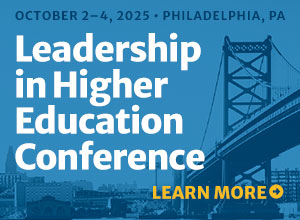Lessons Learned from 13 Years as a Director of Online Education
Back in 2004 I made the decision to develop my first online course. I was using online discussions in one of my face-to-face classes and having success with them—really, my primary motivation to teach fully online. So in 2005 I took the leap and offered my first online class. No...
Fostering Innovation with a Hands-Off Approach
Millersville’s Open Education Working Group was initially formed by like-minded faculty, librarians, and staff who wanted to promote the use of OER across campus. The self-assembled group planned events for Open Education Week and organized a virtual conference to help broaden the understanding and use of OER. The group created an Open...
Program Acquisitions: Lessons for Leaders
In my role as dean of the College of Health and Science at Concordia University, St. Paul (CSP), I collaborated in the acquisition of two resource-intensive healthcare programs associated with university closures. In December 2016, CSP began the acquisition process for a pre-licensure nursing program, and, in March 2019, CSP...
Both Sides, Now: Creating a Culture of UDL
In a 1969 song, Joni Mitchell tells us of how she’s looked at life from “Both Sides, Now.” That is sage advice for considering how Universal Design for Learning (UDL) can benefit students when faculty and administration examine their hopes (and fears) for creating a new learning experience. At two recent...
Recruiting Subject Matter Experts for Curriculum and Course Design: Three Nonmonetary Strategies
For many institutions, attracting quality subject matter experts (SMEs) for curriculum and course design is challenging under the best circumstances. Budgetary constraints often compel institutions to pursue nonmonetary recruitment strategies. Furthermore, money is not always the deciding factor in an SME’s choice of opportunities. Successful, passionate practitioners have many options...
Lessons Learned from the Chinese System of Higher Education
During a brief trip to Beijing, China, during which I presented seminars at three major universities, I had the opportunity to learn more about the Chinese system of higher education. I spoke with a number of professors and graduate students and learned about their perspectives on the educational process at...
The Research Process and Its Relevance to the Culture of Assessment
This article first appeared in Academic Leader on November 30, 2015. © Magna Publications. All rights reserved. As higher education evolves, so too does the importance of assessing learning. New regulations, financial constraints, and accrediting agencies are stressing that colleges and universities should strengthen assessment organizationally. However, when assessment is discussed in large...
Finding Your Unicorns: Creating a Data-Informed Culture
This article first appeared in Academic Leader on January 1, 2018 © Magna Publications. All rights reserved. A recent article, “Higher Education’s Data Experts Face a Crossroads,” in the Chronicle of Higher Education examines the changing profile of institutional researchers. Akin to the characters in the movie Ghostbusters, historically, they were the people you called...
Understanding and Managing Perceptions of Academic Rigor
This article first appeared in Academic Leader on August 25, 2017 © Magna Publications. All rights reserved. Faculty and students are not on the same page about what makes a course rigorous. Draeger, del Prado Hill, and Mahler (2015) find that “faculty perceived learning to be most rigorous when students are actively...
Is Interdisciplinary Scholarship the Future of Higher Education?
This article first appeared in Academic Leader on June 15, 2019. © Magna Publications. All rights reserved. To help students understand how global “grand challenges” cut across multiple fields, a growing number of colleges and universities are creating courses, faculty clusters, and even entire academic tracks that take a multidisciplinary approach to...












